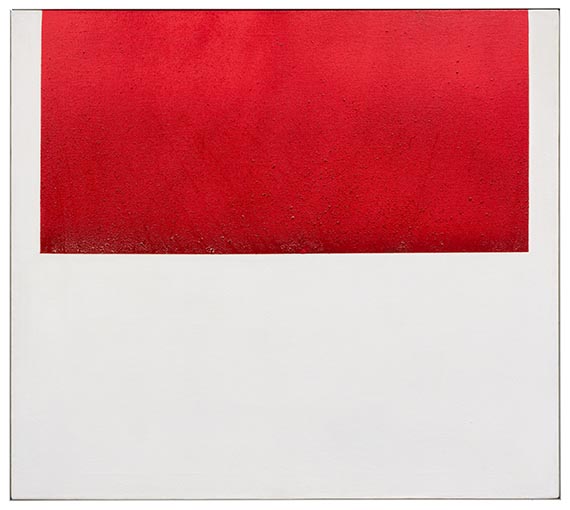129
Rupprecht Geiger
446/66, 1966.
Oil on canvas
Estimate:
€ 40,000 / $ 47,200 Sold:
€ 50,800 / $ 59,944 (incl. surcharge)
446/66. 1966.
Oil on canvas.
Signed and dated on the reverse. Titled on the stretcher. 82 x 90.5 cm (32.2 x 35.6 in). [JS].
• Rupprecht Geiger is one of the most important representatives of German Color Field painting.
• Finely modulated, early color field that impresses with its gentle oscillation of red hues.
• The early luminous compositions are considered Geiger's most sought-after works.
• Geiger's famous color modulations were exhibited several times at documenta between 1959 and 1977.
• Red Color Fields from the 1960s can be found in important collections such as the Städel Museum, Frankfurt am Main, the Städtische Galerie im Lenbachhaus, Munich, the Neue Nationalgalerie, Berlin, and the Pinakothek der Moderne, Munich.
PROVENANCE: Galleria Peccolo, Livorno (label on the stretcher.
Private collection Northern Germany.
EXHIBITION: Rupprecht Geiger, Kestner Gesellschaft, Hannover 1967, p. 61, cat. no. 42 label on the stretcher).
Rupprecht Geiger, Malerei - Graphitzeichnung, Städtische Kunsthalle, Düsseldorf 1967, p. 32, cat. no. 41 (no. fig.).
LITERATURE: Pia Dornacher/Julia Geiger, Rupprecht Geiger. Catalogue raisonné 1942-2002. Gemälde und Objekte, architekturbezogene Kunst, Munich 2003, no. 429 (fig.).
Oil on canvas.
Signed and dated on the reverse. Titled on the stretcher. 82 x 90.5 cm (32.2 x 35.6 in). [JS].
• Rupprecht Geiger is one of the most important representatives of German Color Field painting.
• Finely modulated, early color field that impresses with its gentle oscillation of red hues.
• The early luminous compositions are considered Geiger's most sought-after works.
• Geiger's famous color modulations were exhibited several times at documenta between 1959 and 1977.
• Red Color Fields from the 1960s can be found in important collections such as the Städel Museum, Frankfurt am Main, the Städtische Galerie im Lenbachhaus, Munich, the Neue Nationalgalerie, Berlin, and the Pinakothek der Moderne, Munich.
PROVENANCE: Galleria Peccolo, Livorno (label on the stretcher.
Private collection Northern Germany.
EXHIBITION: Rupprecht Geiger, Kestner Gesellschaft, Hannover 1967, p. 61, cat. no. 42 label on the stretcher).
Rupprecht Geiger, Malerei - Graphitzeichnung, Städtische Kunsthalle, Düsseldorf 1967, p. 32, cat. no. 41 (no. fig.).
LITERATURE: Pia Dornacher/Julia Geiger, Rupprecht Geiger. Catalogue raisonné 1942-2002. Gemälde und Objekte, architekturbezogene Kunst, Munich 2003, no. 429 (fig.).
"The sky is unprecedentedly colorful and incredibly vast. The possibilities are unlimited", Rupprecht Geiger noted in his Russian war diary in 1941 (Rupprecht Geiger, quoted from: Pinc kommt! Rupprecht Geiger, The Schaufler Foundation, Dresden 2017, p. 31). It is the soft color modulations of the sky that appeal to Geiger and which are transformed at night by burning cities into impressive color scenarios that become counter-images to the oppressive reality of war for Geiger. From the 1950s onward, red and blue are the colors that decisively shape the impressive artistic work of the German color field painter Rupprecht Geiger and initially appeared in combination until the end of the 1950s. At the beginning of the 1960s, the two color values were finally clearly separated. While red, as the color of blood and fire, stands for extreme energy and emotional charge, the cooler blue is the more rational, more self-composed color. By using sprayed paint, Geiger gently modulated the red rectangle, which appears to push itself into the format from above, upwards from a rich dark red to a glowing orange and, surrounded by radiant white, has brought it into an almost floating balance. Around 1965, Geiger began to replace his hitherto manual application of paint with that of the spray gun, which henceforth allowed for finer color modulations. The present work is a particularly early example in this new technique. Rupprecht Geiger not only created art-historically significant works with his color modulations, but also with his shaped canvases, which earned him a special progressive position within German post-war art, as Helmut Friedel suggested in the foreword to the catalogue raisonné, demanding stronger comparison with American contemporaries like Mark Rothko, Ellsworth Kelly and Barnett Newman. In the USA, Geiger's paintings were shown in various exhibitions from the 1950s onward and the artist was awarded the Solomon Guggenheim Prize in New York in 1959 . [JS]
129
Rupprecht Geiger
446/66, 1966.
Oil on canvas
Estimate:
€ 40,000 / $ 47,200 Sold:
€ 50,800 / $ 59,944 (incl. surcharge)
Headquarters
Joseph-Wild-Str. 18
81829 Munich
Phone: +49 89 55 244-0
Fax: +49 89 55 244-177
info@kettererkunst.de
Louisa von Saucken / Undine Schleifer
Holstenwall 5
20355 Hamburg
Phone: +49 40 37 49 61-0
Fax: +49 40 37 49 61-66
infohamburg@kettererkunst.de
Dr. Simone Wiechers / Nane Schlage
Fasanenstr. 70
10719 Berlin
Phone: +49 30 88 67 53-63
Fax: +49 30 88 67 56-43
infoberlin@kettererkunst.de
Cordula Lichtenberg
Gertrudenstraße 24-28
50667 Cologne
Phone: +49 221 510 908-15
infokoeln@kettererkunst.de
Hessen
Rhineland-Palatinate
Miriam Heß
Phone: +49 62 21 58 80-038
Fax: +49 62 21 58 80-595
infoheidelberg@kettererkunst.de
We will inform you in time.




 Lot 129
Lot 129 
